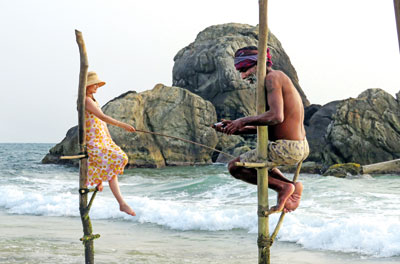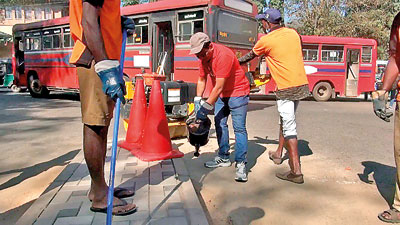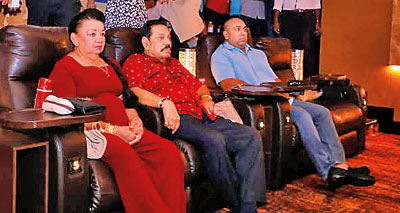Columns
Fish and ‘chips’: Stilt fishermen catch tourists
View(s):Images of stilt fishermen on the southern coast have long been one of the most iconic scenes showcasing Sri Lanka’s tourism. This distinctive traditional form of fishing is famous throughout the world due to the thousands of photographs that have been taken of these fishermen over the years by visiting tourists and professional photographers.
While the practice was very much a source of livelihood for these fishing communities, the tourism boom over the years has now almost killed the tradition.
The Sunday Times recently observed stilt fishermen at work in Koggala, home to at least seven stilt fishing stations.

Rather than in shallow waters, the stilts the fishermen are perched on are now almost on the beach itself, meaning that there are actually no fish to be caught. Instead, the tradition has solely become a photo opportunity meant for eager foreign tourists.
Several stilt fishermen explained that they get on the stilts when foreign tourists arrive and pose for photographs. They also charge Rs. 1000 from an adult foreigner to have his
or her photograph taken on the stilts. The price for a foreign child to do the same is Rs. 500. However, the price increases dramatically for photographs taken at sunset, with foreign tourists being charged Rs. 20,000 to have their photographs taken on the stilts.
USAID makes strange bedfellows: Anti-US Weerawansa hails Trump
The new US administration’s exposé over USAID has set off accusations and counteraccusations in Sri Lanka, where the agency has provided more than $2 billion (nearly Rs720 billion) in assistance since 1956.
Among those thanking US President Donald Trump for exposing alleged misdeeds of USAID was former MP Wimal Weerawansa, a well-known critic of the US. “Many thanks to the American President for exposing the crises created by USAID money in various countries, including Sri Lanka, through George Soros. Moreover, I also ask you to expose the ambassadors, who provided diplomatic support to that chaos,” he wrote on his X account.
Many others, including MP Namal Rajapaksa, too, were also elated by the disclosures happening in the US and wrote to Speaker Jagath Wickramratne, requesting a parliamentary select committee to probe USAID projects in Sri Lanka.
While there are detractors, there are many who have come to the defence of USAID-funded projects, which have helped to finance critically important areas of work in the country.
No monkey tricks: Lalkantha’s phenomenal rise to become ‘Rila’ expert
Agriculture, Lands, Livestock and Irrigation Minister K.D. Lalkantha has been vocal about the need to take drastic measures to limit the damage being done by ‘Rilawas’ (Torque Macaques) to crops.
Addressing a public meeting at Halloluwa in Kandy on Thursday, the minister claimed the government was working on a pilot project in the Kandy district where ‘Rilawas’ will be captured to be sent to an island. He claimed the authorities had already found an island for this purpose.
Minister Lalkantha said research had found that a troop of ‘Rilawas’ can range from a minimum of seven to a maximum of 133. Quoting the figures, he quipped that he had now become a “Rila Expert.”
Within two months of the NPP forming the government, he has become a self-proclaimed ‘expert’ in Torque Macaques. A rare feat, indeed.

- Don’t tarnish Clean Sri Lanka’s image: Minister Samatha Waidyaratne tarring the Badulla bus stand area
Clean Sri Lanka is no media circus, says minister
Plantations and Community Infrastructure Minister Samantha Vidyarathna kicked off the government’s ‘Clean Sri Lanka’ programme in the Badulla district yesterday by taking part in the initiative to clean up and tar the area of the central bus stand in Badulla town.
The sight of Mr. Vidyarathna, clad in a cap, t-shirt, denim, and tennis shoes, recalled how several other government ministers also took part in various initiatives under the ‘Clean Sri Lanka’ project over the past few weeks.
Though the National People’s Power (NPP) government may not like it, such sights and the inevitable photographs that follow in the media also bring back memories of how ministers in various previous governments over the years took part in similar projects, launched under different names. They all served as photo opportunities for the ministers, though many of the projects themselves became consigned to the dustbin of history.
Will ‘Clean Sri Lanka’ follow a similar path? Mr. Vidyarathna addressed the matter directly when speaking during the event at the Badulla bus stand. “Some who see this may think this is similar to media circuses or projects that were launched for political purposes like what happened under previous governments. That is not the case. I urge everyone to understand that this is a project we are launching for the betterment of the country and its future,” he said.
Many SLPPers wary about US ambassador’s visit to party office
Many Pohottuwa (Sri Lanka Podujana Peramuna-SLPP) members were taken aback by the visit to their party office by US Ambassador Julie Chung on Friday, and many were left wondering why she had decided to pay such a visit.
After the meeting, the ambassador posted on her X account that her visit to the SLPP office was “part of our cross-party outreach and that the US-Sri Lanka partnership has long been based on trust, respect, and shared democratic principles.”
An SLPP member who was at the event said they believed that US funds were used to engineer the removal of former President Gotabaya Rajapaksa and that an initial protest in front of the residence of the former President’s son in the USA had been carried out by some beneficiaries of such funds.
They said they believed an activist who is an MP now also benefitted from funds that were disbersed to give publicity to tarnish the image of Gotabaya Rajapaksa. “We are happy she came to our headquarters herself, and we hope to get details of how US funds had been used to fund the Aragalaya to oust President Gotabaya Rajapaksa”.
The ambassadorial visit coincided with SLPP MP Namal Rajapaksa raising the issue of the disbursement of USAID funds in Sri Lanka and calling for a parliamentary select committee on the matter. The young Rajapaksa held talks with Ambassador Chung during her visit.

Rani resurrects MR the HR activist
Former President Mahinda Rajapaksa and former First Lady Shiranthi Rajapaksa this week watched the film ‘Rani.’
The film, directed by award-winning filmmaker Asoka Handagama, is a fictionalised account of the life of Dr. Manorani Saravanamuttu, mother of freelance journalist, dramatist, and civic activist Richard de Zoya, who was abducted and murdered on February 18, 1990.
Mr. Rajapaksa took to social media afterwards to praise the film, also noting that it brought back memories of the era when, as a young MP, he became famous as a “stubborn fighter for human rights,” taking part in protests known as Paada Yaathra (march).
Mr. Rajapaksa noted in his social media post that one of the four key demands of the Paada Yaathra was accountability for enforced disappearances that took place during the 1989-1990 period, when the JVP was pursuing an armed insurrection. The former president recalled that he was the convener of the ‘Mothers’ Front’ as well, a movement representing mothers of disappeared persons, and he was once detained by the authorities at the Bandaranaike International Airport. This was while he tried to take documents containing the names of disappeared persons to be presented to the United Nations Human Rights Council (UNHRC) in Geneva.
Mr. Rajapaksa, who is currently facing issues with the JVP/NPP Government over his official residence, paid tribute to his late parliamentary colleague Mangala Samaraweera (later a cabinet minister) and others who fought by his side during this era. He also offered praise for the performance of actor Bimal Jayakody, who plays the role of Mr. Rajapaksa in the film.
PMB lacks ABC of marketing
Although the Government set out to take on big-time rice millers, or the ‘rice mafia’ as they are being referred to, it seems like farmers prefer to do business with them than the state-owned Paddy Marketing Board (PMB).
Since the government announced it would buy paddy at Rs.120 a kilo for some varieties, only 700 kilos were sold to the PMB,
with most farmers selling their harvest
to big-time millers.
Farmers say private mill owners come to collect the paddy, sparing them the transport costs, and buy the paddy at a reasonable price as well, while they have to hire vehicles to get to PMD outlets, which not only costs money but also time and energy. For now at least, the so-called ‘rice mafia’ is having the upper hand.
It appears that the paddy marketing authorities lack the basics of marketing.
Buying or selling electronics has never been easier with the help of Hitad.lk! We, at Hitad.lk, hear your needs and endeavour to provide you with the perfect listings of electronics; because we have listings for nearly anything! Search for your favourite electronic items for sale on Hitad.lk today!


Leave a Reply
Post Comment